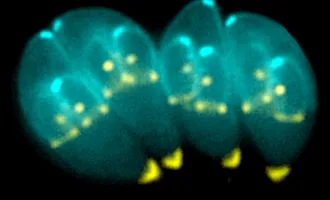Journal Club: Neuroscience, and Cancer Biology
NEUROSCIENCE: LTP requires a reserve pool of glutamate receptors independent of subunit type. Granger, A.J.; Shi, Y.; Lu, W.; Cerpas, M.; Nicoll, R.A. Nature. December 12. [Epub ahead of print]
It is thought that memory formation requires a form of neuronal communication called “long-term potentiation” (LTP), where continued signaling from one neuron to another causes increased receptivity of the receiving neuron (either via neurotransmitter receptors, dendritic spines or ion channels) and strengthens activation of the receiving neuron. This type of activity can persist for days to months and is a basic mechanism of synaptic plasticity.
One type of neurotransmitter receptor thought to be required for LTP is the glutamate receptor AMDA, and especially the GluA1 subunit of AMDA. Previous reports have named the C-terminus (read: the back end) of GluA1 as required for LTP to occur, as truncations of GluA1 prevented LTP in in vitro and in vivo models.
Here, researchers tested this assertion by knocking out different portions of the C-terminus with a gene gun, which essentially forces DNA into cells in culture. Interestingly, they found that deletion of the C-terminus of GluA1 did not ablate LTP significantly, and LTP only requires a reserve pool of AMDA receptors to occur.
CANCER BIOLOGY: Identification of pY654-β-catenin as a critical co-factor in hypoxia-inducible factor-1α (HIF-1α) signaling and tumor responses to hypoxia. Xi, Y. et al. (Chapman and Wei) Oncogene. December 17. [Epub ahead of print]
Recent advances in the understanding of cancer biology have uncovered what looks like a common route of metastasis in many cancers: a damaged cell’s response to a hypoxic environment. In tumors and healthy cells, exposure to hypoxia promotes expression of HIF-1α. Somehow, this HIF-1α gets activated in tumor cells but not in healthy cells and promotes what’s called the “epithelial to mesenchymal transition” or EMT — a hallmark of metastasis.
Here, researchers have elucidated the mechanism underlying this pathway to metastasis. They found that phosphorylated β-catenin accumulates in lung carcinomas and that upon exposure to hypoxia, the β-catenin activates the newly produced HIF-1α. They propose that the accumulation of phosphorylated β-catenin can be due to a variety of mutated kinases, which normally only activate β-catenin under specific circumstances.
CELL BIOLOGY: Phosphorylation of actin-related protein 2 (Arp2) is required for normal development and cAMP chemotaxis in Dictyostelium. Choi, C.H.; Thomason, P.A.; Zaki, M.; Insall, R.H.; Barber, D.L. Journal of Biological Chemistry. December 5. [Epub ahead of print]
Arp2, along with Arp3, forms a protein complex that helps nucleate the formation of actin filaments of the cell’s cytoskeleton by binding to mature actin fibers and adding new actin monomers as a new branch of the original fiber. To function, these proteins must be phosphorylated.
Given their very fundamental role in generating the actin cytoskeleton, Arp2 and Arp3 are both required for many basic functions of most eukaryotic cells, such as cell migration, changes in membrane shape and endocytosis.
Here, researchers investigated the role of Arp2 in the early development of Dictyostelium, a slime mold that serves as a useful model of eukaryotes. Arp2 mutants that could not be phosphorylated showed significant defects in cyclic-AMP chemotaxis and pseudopod formation in addition to delayed development, but only subtle defects in endocytosis and folate chemotaxis.
CELL BIOLOGY: Polysialic acid enhances the migration and invasion of human cytotrophoblasts. Hromatka, B.S. et al. (Fisher). Glycobiology. December 3. [Epub ahead of print]
In the early developmental period of placental mammals, the growing fetus develops a link to maternal nutrients via formation of a placenta. Essentially, the placenta is a collection of capillary beds that intertwine with maternal capillary beds of the uterus to provide a place to exchange oxygen, nutrients and waste.
To generate the placenta, fetal cells called trophoblasts must actually invade the maternal tissue to develop these vascular connections. Understanding the regulatory mechanisms that control this invasion could help treat dangerous conditions of abnormal placentation.
Here, researchers identify polysialic acid, a sugar present on the surface of fetal trophoblasts that controls its level of maternal invasion. Absence of the sugar prevented trophoblast migration into maternal tissue in vitro, whereas addition of the sugar promoted it. Furthermore, they found abnormally high levels of polysialic acid in diseases that involve too much trophoblastic invasion, such as molar pregnancy and choriocarcinoma.
For comments or paper suggestions, email Alexandra at Alexandra.Greer@ucsf.edu.



